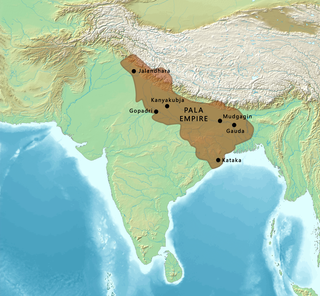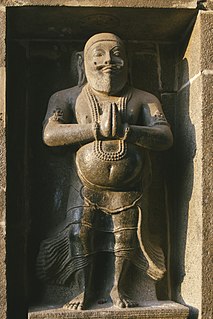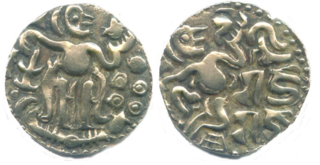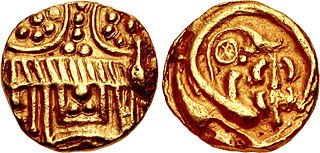Related Research Articles

The Middle kingdoms of India were the political entities in the Indian subcontinent from 200 BCE to 1200 CE. The period begins after the decline of the Maurya Empire and the corresponding rise of the Satavahana dynasty, starting with Simuka, from 230 BCE. The "Middle" period lasted for about 1,500 years and ended in 1200 CE, with the rise of the Delhi Sultanate, founded in 1206, and the end of the Later Cholas.

The Pala Empire was an imperial power during the post-classical period in the Indian subcontinent, which originated in the region of Bengal. It is named after its ruling dynasty, whose rulers bore names ending with the suffix Pala. The empire was founded with the election of Gopala as the emperor of Gauda in 750 CE. The Pala stronghold was located in Bengal and eastern Bihar, which included the major cities of Gauda, Vikrampura, Pataliputra, Monghyr, Somapura, Ramvati (Varendra), Tamralipta and Jaggadala.

Kulottunga I also spelt Kulothunga, was a Chalukya Chola Emperor who reigned from 1070 CE to 1122 CE succeeding his cousin Athirajindra. He also served as the Eastern Chalukya Emperor from 1061 CE to 1118 CE, succeeding his father Rajaraja Narendra. His birth name was Rajendra. He is related to the Chola dynasty though his mother's side and the Eastern Chalukyas through his father's side. His mother, Ammangaidevi, was a Chola princess and the daughter of emperor Rajendra I. His father was king Rajaraja Narendra of the Eastern Chalukya dynasty who was the nephew of Rajendra I and maternal grandson of Rajaraja I. According to historian Sailendra Nath Sen, his accession marked the beginning of a new era and ushered in a period of internal peace and benevolent administration.

Rajendra Chola I , often referred to as Rajendra the Great, and also known as Gangaikonda Chola, and Kadaram Kondan was a Chola Emperor who reigned between 1014 and 1044 CE. Rajendra had ascended the throne in 1014 CE, around the age of 43. He also served as the Co-Regent under his father Rajaraja I from 1012 CE to 1014 CE. Rajendra was one of the few Indian monarchs to conquer territory outside the Indian Subcontinent. Under his reign, the Chola Dynasty was expanded to its greatest extent, dominating trade throughout the Indian Ocean.

Rajadhiraja I was a Chola emperor, the most skilled commander among the Chola monarchs and the successor of his father, Rajendra I. He was the only Chola emperor who was killed fighting in a war, and during his short reign, he helped his father conquer several territories as well as to maintain the Chola authority over most of Sri Lanka, Eastern Chalukya, Kalinga, among others and also the relations with overseas allies despite a series of revolts in the territory.

The Chola Dynasty was a Tamil thalassocratic empire of southern India, one of the longest-ruling dynasties in world history. The earliest datable references to the Chola are in inscriptions from the 3rd century BCE left by Ashoka, of the Maurya Empire. As one of the Three Crowned Kings of Tamilakam, along with the Chera and Pandya, the dynasty continued to govern over varying territory until the 13th century CE. Despite these ancient origins, the period when it is appropriate to speak of a "Chola Empire" only begins with the medieval Cholas in the mid-9th century CE.
Ilamchetchenni was an early Tamil king of the Chola dynasty during the Sangam period. He was a great warrior and ruled the Chola kingdom with Uraiyur as the capital. He married a Velir princess from Alundur and their child was Karikala Chola. Ilamchetchenni Chola was succeeded by his son, Karikala Chola, who is considered one of the greatest among the Early Cholas.

Someshvara I was a king of the Western Chalukyas. Also known as "Ahavamalla" or "Trilokamalla", Someshvara succeeded his father Jayasimha II to the throne.
The Chola military was the combined armed forces of the Chola Empire organized during two separate Tamil golden ages, the Sangam Period and the Medieval Era. The Chola military fought dozens of wars during a timespan of approximately 1580 years (300BCs–1279AD), during which the Chola armed forces underwent numerous changes in structure, organization, equipment and tactics, while conserving a core of lasting Tamil traditions.

The Kamboja-Pala dynasty ruled parts of Bengal in the 10th to 11th centuries CE, after invading the Palas during the reign of Gopala II. The last Kamboja Kamboh ruler of the Kamboja-Pala Dynasty Dharmapala was defeated by the south Indian Emperor Rajendra Chola I of the Chola dynasty in the 11th century.

Devapala (9th century) was the most powerful ruler of the Pala Empire of Bengal region in the Indian Subcontinent. He was the third king in the line, and had succeeded his father Dharamapala. Devapala expanded the frontiers of the empire by conquering the present-day Assam and Orissa. The Pala inscriptions also credit him with several other victories, but these claims are thought to be exaggerated.
Rajyapala or Kamboja-Vamsa-Tilaka was the founder of the Kamboja Pala dynasty of Bengal. This dynasty had ruled over northern and western Bengal. Four rulers of this dynasty are known who ruled, either over north-west Bengal or parts thereof, from second half of tenth century to the first quarter of the 11th century. The last known king of Kamboja Pala dynasty was Dharmapala, who was the ruler in Dandabhukti division, during the first quarter of the 11th century.

The Eastern Ganga dynasty also known as Rudhi Gangas or Prachya Gangas were a large medieval era Indian royal dynasty that reigned from Kalinga from as early as the 5th century to the early 15th century. They are known as "Eastern Gangas" to distinguish them from the Western Gangas who ruled over Karnataka. The territory ruled by the dynasty consisted of the whole of the modern-day Indian state of Odisha as well as major parts of West Bengal, Andhra Pradesh and Chhattisgarh. The early rulers of the dynasty ruled from Dantapuram; the capital was later moved to Kalinganagara, and ultimately to Kataka . Today, they are most remembered as the builders of the world renowned Puri Jagannath Temple and Konark Sun Temple, a UNESCO World Heritage Site at Konark, Odisha.

The Cholas did not have a standing navy in modern sense. The maritime force of Cholas was formed from using ships used for trade, as they did not have a dedicated ship for naval combat. The ships were used for transporting the land army overseas.

The Tondaiman family were Tamil rulers of the ancient Tondai Nadu (Tondaimandalam) division of Tamilakkam in South India. Their capital was at Kanchipuram.
Dandabhukti was an ancient and medieval region located amidst the two rivers, Dwarakeswar and Subarnarekha. It was situated within the Rarh region, a part of the Gupta Empire. It spanned an area that now comprises Bankura, Hooghly, Paschim Medinipur, and Purba Medinipur districts in the Indian state of West Bengal.

Karunakara Tondaiman was a general of Chola Emperor Kulottunga I. He is renowned for leading the Chola invasion of Kalinga during the reign of Kulottunga I and is the hero of Jayamkondar's poem Kalinkkattuparani In the Parani poem he is referred to as the lord of Vandai. while in the Draksharamam inscription of Kulottunga I, he is called as Vanduvaraja and Pallavaraja. He also served as a minister under Kulothunga Chola's son and successor, Vikrama Chola.

The Medieval Chola emperor Rajendra Chola I led an expedition to North India between 1019 and 1024. The expedition traversed the states of Vengi, Kalinga, Odda and Bengal culminating with their arrival at the Ganges river. The Chola victory over the Pala king Mahipala I is considered to be the climax of the expedition. In 1019 CE, Rajendra’s forces marched through Kalinga towards the river Ganga. In Kalinga the Chola forces defeated Indraratha the ruler of the Somavamsi Dynasty. The Chola army eventually reached the Pala kingdom of Bengal where they defeated Mahipala. The Chola army also defeated the last ruler of the Kamboja Pala dynasty Dharmapala of Dandabhukti. The Chola army went on to raid East Bengal and defeated Govindachandra of the Chandra dynasty and invaded Bastar region.
Naralokaviran, also known as Kalinga Rayan, was a general in the Chola army during the reign of Kulottunga I and his successor Vikrama Chola. He was the headman of Arumbakkam and a resident of Manavil in Manavil Nadu in Tondai Mandalam. He maintained a large fief at Manavil. Naralokaviran led many Chola campaigns in the deep south and distinguished himself in the Pandya Wars. He had many titles like Madurantaka Ponnambala-koothar, Sabharnataka, Kalinga Rayan, Porkoyil-Tondaiman, Koothan, Tondaiyarkon, the Lion of Kalinga.
Muttaraiyan was a title used by various officials in the Chola government during the medieval period. It should not be confused with the Muthuraja caste and has been borne by persons from various communities. For example, there was one Virarajendra Brahmadhiraya Muttaraiyan and Vikramasola Brahmadiraya Muttaraiyan who were feudatories of Kulothunga Chola III. These two vassals were not Muthuraja chiefs as the word Brahmadiraya meant Brahmin chiefs only.
References
- ↑ The Indian Historical Quarterly, 1963, p 508 India; History of Bengal, I, p 139
- ↑ The People and Culture of Bengal, a Study in Origins, 2002, p 562, Annapurna Chattopadhyaya.
- ↑ Ancient India, History and Archaeology, 1994, p 53, Dilip Kumar Ganguly.
- ↑ See refs: The Early Rulers of Khajurāho, 1977, p 63, Sisirkumar Mitra
- ↑ The Indian Historical Quarterly, 1963, p 508.
- ↑ Journal of the Varendra Research Museum, 1972, p 109, Varendra Research Museum, Varendra Research Museum - Bangladesh.
- ↑ The Orissa Historical Research Journal, 1975, p 114, Kedarnath Mahapatra, Orissa (India) Superintendent, Research and Museum, Orissa State Museum - Orissa (India).
- ↑ West Bengal District Gazetteers, 1965, p 73, Editor Jatindra Chandra Sengupta.
- ↑ Historical geography and dynastic history of Orissa, up to the rise of the imperial Gaṅgas, 1975, p 66, Dilip Kumar Ganguly.
- ↑ Cf: The Early Rulers of Khajurāho, 1958, p 62-63, Sisirkumar Mitra; Ancient Indian History and Civilization, 1999, p 281, Sailendra Nath Sen.
- ↑ Some Historical Aspects of the Inscriptions of Bengal: Pre-Muhammadan Epochs., 1942, p 399, Benoychandra Sen.
- ↑ Epigraphia Indica, Vol V, pp 105-106, (Editor) E. Hultsch; A Comprehensive History of India, 1957, p 39, Kallidaikurichi Aiyah Nilakanta Sastri, Indian History Congress; History of Tamilnad, 1978, p 222, N. Subrahmanian - Tamil Nadu (India)
- ↑ A Comprehensive History of India, 1957, p 15, Kallidaikurichi Aiyah Nilakanta Sastri, Indian History Congress - India.
- ↑ History of Bengal, Vol I, p 139, Edi. R. C. Majumdar, Reprint, Delhi, B.R. Publishing, 2003, ISBN 81-7646-238-1.
- ↑ cf: Decline of kingdom of Magdha, p 413, f.n. 2; Sinha B. P; Cf: Journal of Oriental Research, Madras (JOR), XIX, pp. 151.
- ↑ From Sanskrit section of Sangham Copper Plate Charter, See: Journal of Indian History: Golden Jubilee Volume, 1973, p 114, T. K. Ravindran, Trivandrum, India (City). University of Kerala. Dept. of History, University of Kerala; The Journal of Oriental Research, 1952, p 151, Kuppuswami Sastri Research Institute, Indo-Aryan philology.
- ↑ Journal of Indian History, 1973, p 114, T. K. Ravindram, University of Kerala, Department of History.
- ↑ .The Cōlas, 1955, p 220, Kallidaikurichi Aiyah Nilakanta Sastri, - Chola (Indic people); Encyclopaedia of Tamil literature, 1990, p 68, Shu Hikosaka, Institute of Asian Studies (Madras, India), G. John Samuel; A Comprehensive History of India, 1957, p 15, Kallidaikurichi Aiyah Nilakanta Sastri, Indian History Congress; See also: The Journal of Oriental Research, 1952, p 151, Kuppuswami Sastri Research Institute, Indo-Aryan philology.
- ↑ The Orissa Historical Research Journal, 1975, p 114, Kedarnath Mahapatra, Orissa (India) Superintendent, Research and Museum, Orissa State Museum - Orissa (India).
- ↑ West Bengal District Gazetteers, 1985, p 87, Editor Jatindra Chandra Sengupta; Also see: West Bengal District Gazetteers, 1965, p 63, West Bengal (India), Jatindra Chandra Sengupta - West Bengal (India) - 1965.
- ↑ History of Bengal, Vol I, p 139, Edi. R. C. Majumdar, Reprint, Delhi, B.R. Publishing, 2003, ISBN 81-7646-238-1.
- ↑ Ancient India, History and Archaeology, 1994, p 53, Dilip Kumar Ganguly; Abhinandana-Bhāratī: Professor Krishna Kanta Handiqui Felicitation Volume, 1982, p 110, Krishna Kanta Handiqui, Pratap Chandra Choudhury, Biswanarayan Shastri; cf: Decline of kingdom of Magdha, p 413, f.n. 2; Sinha B. P; Cf: Journal of Oriental Research, Madras (JOR), XIX, pp. 151.
- ↑ Proceedings of the Indian Science Congress, 1953, p 10, Indian Science Congress Association, Royal Asiatic Society of Bengal).